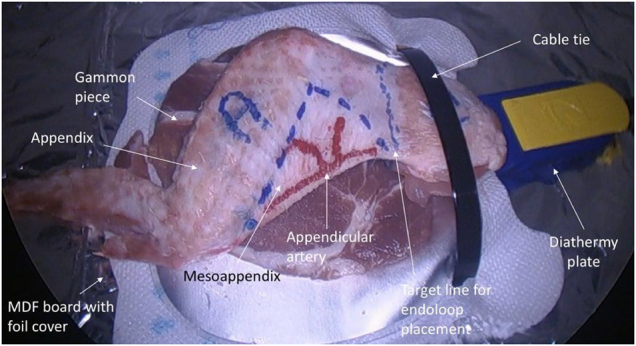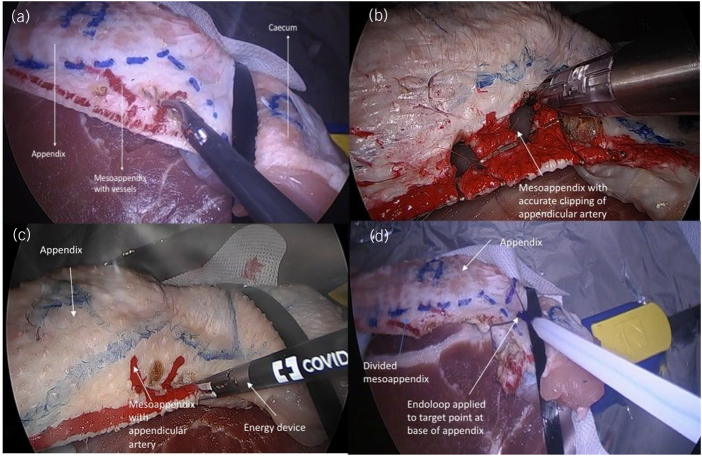Background
Modern surgical training places emphasis on simulation outside of the operating theatre and laparoscopic appendicectomy is no exception.1 However, available models can be expensive and inaccessible for some trainees.2 Junior surgeons have reported that the most difficult step of laparoscopic appendicectomy is the division and ligation of the mesoappendix and appendicular vessels.3 Commercial synthetic appendicectomy models do not allow energy device practice of this crucial step and the available animal tissue models can only be used in wet-lab settings.2 We describe a training model that is inexpensive, easy to replicate and overcomes these limitations.
Technique
Perforated medium-density fibreboard (MDF) is covered with kitchen foil as a reusable base plate. Supermarket-grade gammon steak is used to secure a diathermy pad connection. Food-grade chicken wings are strapped to the board using cable ties. A permanent marker is used to delineate the model ‘mesoappendix’ on the fleshy border of the wing. The appendicular vessels and a target for endoloop application are drawn onto the model. Hence, the model is divided into mock ‘caecum’, ‘appendix’ and ‘mesoappendix’ (Figure 1). Assembly takes 2 minutes and costs £0.40. The model is inserted into any box trainer and the trainee practices hook dissection, clipping and energy device control of appendicle artery and endoloop placement (Figure 2).
Figure 1 .

Completed appendicectomy model with labels for appendix (A), caecum (C; visible under cable tie) and mesoappendix. The specimen is secured on the diathermy plate by cable ties passed through a perforation in the MDF board. Appendicular artery and target line for endoloop placement are drawn on the model.
Figure 2 .
(a) Appendicular artery dissected and controlled with bipolar diathermy forceps. (b) Precise clipping or branches of appendicular artery. (c) Control of mesoappendix with energy device. (d) Endoloop placement on target line.
Discussion
We have described the construction of a simple, low-cost, replicable and efficient model for teaching challenging key steps of laparoscopic appendicectomy which we tested successfully with ten trainees. We suggest testing its validity in a larger sample group and on relevant courses.
References
- 1.Ashley SW. Surgical skills training and simulation. Curr Probl Surg 2009; 46: 263–270. 10.1067/j.cpsurg.2008.12.001 [DOI] [PubMed] [Google Scholar]
- 2.Roberts KE, Bell RL, Duffy AJ. Evolution of surgical skills training. World J Gastroenterol 2006; 12: 3219–3224. 10.3748/wjg.v12.i20.3219 [DOI] [PMC free article] [PubMed] [Google Scholar]
- 3.Jaffer U, Cameron AE. Laparoscopic appendectomy: a junior trainee's learning curve. JSLS 2008; 12: 288–291. [PMC free article] [PubMed] [Google Scholar]



